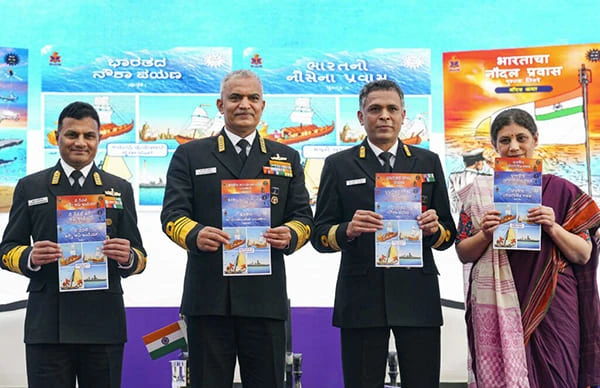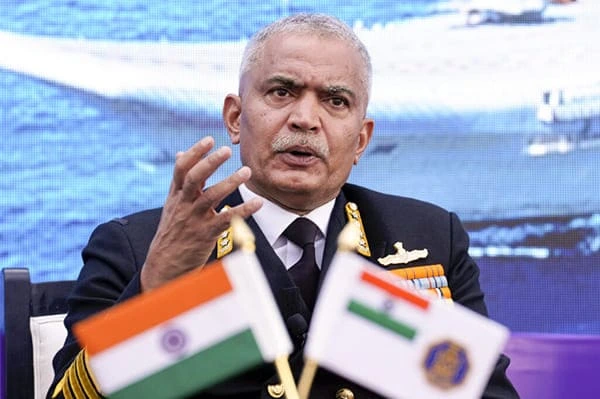Indian Navy Chief Admiral R Hari Kumar addressed a press conference ahead of the Navy Day celebrations, in New Delhi on 1 December 2023. He said that the task of the Indian Navy is to protect, preserve, promote, and pursue Bharat’s national interest in the maritime domain, wherever they lie. He asserted that India is the resident power in the Indian Ocean region, notwithstanding the growing Chinese presence in the area.
He said as India’s maritime interests and investments grow, it will mandate expansion in the Navy’s responsibilities and operational footprint to protect these interests.
Operational Readiness
In terms of operational readiness, he said, “Our ‘Mission Based Deployment’ philosophy has enhanced the Indian Navy’s presence across the region, enabling rapid responses to emerging security challenges. The Indian Navy has established a persistent footprint in our areas of interest. Naval deployments also serve as a deterrent to inimical interests, clearly signalling the Navy’s reach, capability and intent.”
Maritime Surveillance
“The oceans are considered to be a common heritage; they can be used for the legitimate economic aspirations of any nation. So in that regard, if you look at China, it may have a legitimate reason to be present in the Indian Ocean region for economic activities. But we, as the resident naval power in the Indian Ocean, keep an eye on what all is happening there,” the Naval chief said.
“We try to keep the extra regional forces that are present in the region under surveillance and keep a watch on their activities–what are they engaged in, what are their intentions and so on. So, that is why we deploy our surveillance assets–ships, submarines, aircraft, UAVs and others. So they’re deployed regularly to keep our area of interest and observation.”
“Our interests are there in the Indian Ocean region and beyond when you look at the Indo-Pacific. So our ships, submarines, and aircraft are deployed accordingly. We try to keep our area of interest under surveillance,” he said.
Admiral Kumar also talked about the naval air surveillance part and said that, looking at the surveillance aspect, each of the platforms comes with a particular type of capability.
“When you talk of the P-8I, while it has a secondary role for surveillance, it is essentially a submarine warfare aircraft. It is basically an asset that is meant to detect localised and targeted submarines. But when it is not engaged in the task, it can also be used for surveillance.”
He also mentioned numerous other primary assets for surveillance but he stated that when an entire ocean area is looked upon, assets with different capabilities will be required. So we have to divide the area that we want to keep under surveillance with different types of assets.

Chinese Forays in the Indian Ocean
Speaking about increasing Chinese forays into the Indian Ocean Region, Adm Kumar said China may have legitimate reason to be present in the IOR for economic activities. “We keep an eye on what all is happening there. We try to maintain surveillance of the extra regional forces present in this region and would like to know what activities they are engaged in and their intentions,” he said.
He said the Navy’s ships, submarines, and aircraft have sustained a high operational tempo and have undertaken missions and tasks encompassing military, diplomatic, constabulary and benign roles, adding that naval units were on mission-based deployments across the IOR and beyond to protect and promote India’s national interests.
He said there are disputes in the Indo-Pacific which have the possibility of turning into conflicts and there are challenges such as IUU fishing, drug trafficking, piracy, illegal migration and robbery and it is important that dialogues continue to maintain peace and tranquillity in the Indo-Pacific.
Regarding the India-China standoff in Ladakh, he said, “Security situation on India’s northern borders has added to our security complexities.”
India-US Partnership
Admiral Kumar also said India has a long-standing partnership with the US and both countries have participated in a range of exercises, including Malabar, which began in 1993 and over the years have turned into a complex multilateral exercise, and other defence agreements signed between the two countries.
He said the Indian Navy and the US Navy have reached a high level of interoperability in joint exercises involving ships, submarines, aircraft and aircraft carriers.
In the last year, both sides have signed an agreement to develop underwater domain awareness and there is also enhanced cooperation between the two sides on technology, Admiral Kumar said, highlighting Indian shipyards’ growing capabilities in shipbuilding and repairs and India procuring MQ9B drones from the US.
Ties with Maldives
Maldives President Dr Mohamed Muizzu had formally sought withdrawal of Indian military personnel from Maldives during a meeting with Minister of Earth Sciences Kiren Rijiju, in late November.
On cooperation with Maldives, Adm Kumar, said that India has close cooperation with Maldives and any decision to scale down Indian military personnel presence from the key island nation will be based on instructions from the Central Government. “As far as scaling down of personnel is concerned, it is a decision of the government. Whatever instructions are given to us, we will follow,” he said, emphasising New Delhi’s close ties with the country in spheres of training as well as Maldives’ participation in important events organised recently by the Navy such as the Goa Maritime Conclave and the Indo-Pacific Regional Dialogue.
He said that India has “a few assets” deployed in Maldives, adding that India has assisted the country in multiple ways over the last five years, including carrying out over 500 medical evacuations, and helping the country with surveillance to detect illegal activities in the maritime domain.
Maldives is among the key maritime neighbours of India in the Indian Ocean Region (IOR) and India has been seeking to expand ties with the island nation — including in areas of defence and security — amid China’s efforts to expand its influence in the region. In May, both countries had launched the construction of a harbour for the Coast Guard of the Maldives National Defence Force (MNDF).
Naval Ex-Servicemen in Qatari Prison
To a question on the status of the eight former Naval personnel in Qatar, Admiral Kumar said the government is making extensive efforts to repatriate them. “We are working closely to ensure that their interests are looked after. The government of India is putting all-out efforts to ensure they are brought back,” he said.
The former Navy personnel were given death sentence by Qatar’s Court of First Instance on October 26, following which an appeal has already been filed against the death sentence, which has been admitted by a higher court in Qatar. The charges in the case have not been made public.
Atmanirbharta
Admiral Kumar said the Navy has made a univocal commitment to be fully “atmanirbhar” by 2047 in capabilities, capacities and concepts, while stating that the Navy is committed to greater jointness between the defence forces.
According to the Chief, the Navy’s commitment to ‘Aatmanirbharta’ will be reinforced by indigenisation of major equipment and systems through multiple avenues including the flagship ‘Make in India’ campaign. “We will continue with our sustained efforts to support the national initiatives such as Digital India, Skill India, Startup India and other GoI initiatives,” he said.
He briefly spoke about all these initiatives and the role that the navy is playing to support these. Regarding Start-Up India, he said that the navy in the past year had ‘supported, funded and hand-held more than 35 start-ups and Micro, Small and Medium Enterprises (MSMEs) for various projects towards developing niche technologies or products for the Navy.’ Last year, the Navy facilitated employment of 88 personnel to these MSMEs. Memorandums of Understanding (MoUs) have recently been concluded with two companies through which close to 100 personnel are pursuing their second career options.
Op Samudra Setu
Regarding the navy’s efforts to combat Covid, he said that the Indian Navy had played a role of ‘care-giver’ during the pandemic. Listing the efforts, he said that 10 naval ships, under the aegis of Operation Samudra Setu II, transhipped more than 1100 Metric Tons of Liquid Medical Oxygen to India. “Missions Sagar III to VII,” he said, “reiterated India’s commitment to the region, as IN ships and aircrafts provided COVID assistance to eight friendly foreign countries across the oceans through deployment of Naval medical teams, medicines, vaccines and humanitarian aid.” He added that despite the disruptive impact of the pandemic, the navy had maintained its operational readiness and tempo through prompt implementation of preventive protocols. Our focus on maintaining combat and mission readiness resulted in deterring any misadventure in the maritime domain, while contributing to the national COVID effort—both internally and across the seas.”
Organisational Reforms
Speaking about the reforms in defence, the chief of naval staff said, “I would like to reiterate the navy’s wholehearted support for reforms in our Higher Defence Organisation, and on enhancing tri-service synergy. We are looking at establishment of the ‘Maritime Theatre Command’ in the near future, which would further buttress ‘Joint planning and Joint application of force’ in the maritime domain. The details are being worked out and may be finalised by the mid of next year.”
Women Agniveers
Adm Kumar said that more than 1,000 women ‘Agniveers’ have been incorporated into the force. He lauded the Agnipath scheme and said its implementation has been a much-needed, transformational change.
“Our first batch of ‘Agniveers’ graduated from the premier-winning establishment, INS Chilka, in March this year. And importantly, this batch of Agniveers includes 272 female Agniveer trainees as well,” Admiral Kumar said.
“And going further, the second batch of ‘Agniveers’ had a total of 454 women and I want to say that with the third batch, which has just been inducted, we have now crossed over 1000 women affiliates in the navy,” he added.
Admiral Kumar asserted that these statistics stand testament to the Indian Navy’s philosophy of all roles and all ranks with regard to the deployment of women in the service, both for officers and for personnel below the rank of officer.
“We also appointed the first woman commanding officer of an Indian naval ship. It has been our effort to constantly challenge the status quo to ensure that the navy remains on an aspirational and dynamic trajectory into the future,” said Admiral Kumar.
“We have taken measures towards providing additional opportunities for women officers in the Navy. Women officers have been appointed on-board almost all major warships.” Briefly touching upon recent developments in consonance with the government of India’s objective to empower women, Admiral Kumar said, “We have taken measures towards providing additional opportunities for women officers in the Navy. Women officers have been appointed on-board almost all major warships, the first woman Provost officer joined the specialization in March this year, and induction of women officers into the Information Technology Branch will commence from June next year.”


















